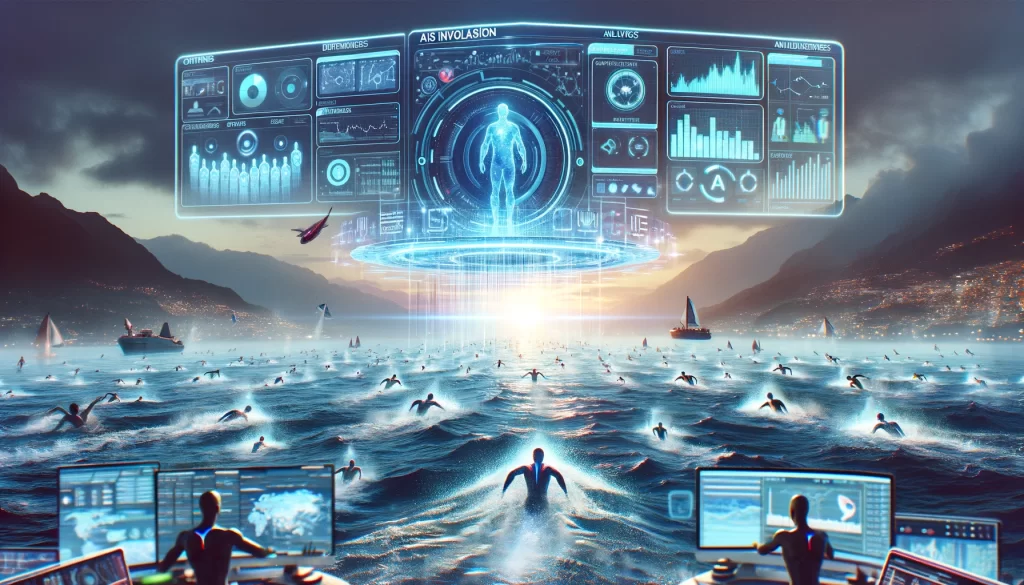Extreme swim nonprofits organise difficult open water swimming events to raise money for charitable causes. However, running these complex occasions places immense strain on human resources. This article explores how integrating artificial intelligence (AI) tools could optimize multiple aspects of extreme swims – improving experiences while directing more funds to nonprofit beneficiaries.
“AI has significant potential to assist extreme swim nonprofits achieve their goals.”
Using AI to Optimize Swimmer Tracking
Safely tracking each swimmer’s location is paramount but extremely hard to manage manually across long distances. AI swim tracking platforms now provide:
- Real-time GPS data on all participants
- Accurate swim time measurements
- Alerts if anyone falls behind
This level of automation frees lifeguards andsafety crews from continual watchduty to focus on those needing assistance. For example, UK-based Nimble Fins uses radio wave signals to pinpoint swimmer positions via electronic anklet tags. Their AI dashboardvisualises this data, including indicators when someone goes off course.
AI Performance Analysis to Improve Technique
Open water swims place heavy demands on sporting technique to handle waves, unpredictable weather and craming. AI-enabled video analysis can now identify personalised improvements for each participant such as:
- Inefficient stroke patterns
- Poor body position in water
- Overcompensation that may cause injury
Canada’s PlaySight makes this possible by combining underwater and aerial filming with motion tracking algorithms. Their AI Coach highlights flaws and suggests drills tailored to every swimmer for rapid correction. This allows self-optimization mid-event.
Automated Fundraising Updates Through AI
Extreme swim participants also commit sponsors to donate funds depending on performance like speed or distance targets. But collecting these pledged funds afterwards requires considerable administration if done manually. AI automation can provide the solution via:
- Personalised real-time progress messages sent to each sponsor during the event
- Automated post-event calculation of total funds pledged per person based on achieved metrics
- Direct integration into fundraising platforms to seamlessly collect sponsorship money
This makes the fundraising processmore rewarding for sponsors to support their chosen swimmer’s achievements. For participants facing exhaustion in open waters, knowing their efforts trigger instant AI updates offers a psychological lift too.
Virtual Assistants Manage Logistics and Questions
In the build up to extremeswims, participants and donors bombard organisers with myriad logistical and technical questions around training, locations, timing etc. AI chatbots offer 24/7 self-service assistance by handling hundreds of routine queries, freeing up human resources. For example, US platform Anthropic created Claude – an AI able to answer correctly 88% of times across any domain by learning context. Claude demonstrated the potential at recent open water events.
AI Audits Ensure Compliance and Certification
With sizable fundraising sums changing hands, extreme swim nonprofits must adhere closely to financial regulations around donations, expenses etc. But compliance checks are monotonous and time-intensive for humans. Integrating intelligent document analysis tools like UK-based Eigen allows rapid auditing via:
- Automated scanning of all invoices, bank statements, receipts
- Flagging anomalies against nonprofit accounting rules
- Dynamic production of compliance reports and summaries
This provides auditable transparency for regulators while reducing the admin burden on stretched teams. Eigen boasts reducing financial document handling efforts by up to 90% for leading charities.
Conclusion
The scope for AI assisting extreme swim nonprofits is compelling yet remains underexploited currently. The technology can act as an extra ‘pair of hands’ to handle major logistical and analytical problems these inspiring events grapple with. Crucially, expert systems enhance rather than replace the human element that lies at the heart of both open water swimming endeavours and the charitable ethos underpinning them. Handled carefully, AI adoption has the capacity to boost fundraising incomes considerably while making participating more enjoyable and safer for all involved.
FAQs
How can AI identify open water swimming technique improvements?
AI-enabled platforms analyze video recordings of swimmers, using motion tracking and pose estimation algorithms. This data identifies inefficient stroke patterns, asymmetric movements that could cause injury, poor body position in water, and more. The AI then suggests customized drills to address these technique flaws.
What metrics can AI track for extreme swim participants?
Real-time swimmer tracking platforms can monitor participants’ location using electronic tags, speed, distance covered, whether anyone is drifting off course, help signals, swim style changes indicating tiredness, and any other definable performance metrics.
How does AI help manage fundraising around extreme swim events?
AI tools can automatically send each sponsor real-time personalized updates on a swimmer’s progress to make the fundraising process more dynamic and rewarding. Post-event, AI tallies total distances achieved to calculate funds pledged, integrating directly with nonprofit fundraising platforms for streamlined collection.
What logistical questions can a swim event chatbot handle?
Intelligent chatbots can address most routine enquiries around transportation, equipment requirements, event timings/schedules, medical provisions, accommodation options, changing facilities, insurance documentation and any other organizational queries. This allows human staff to focus on high-level planning and participant support.
Does using more AI reduce the need for human resources?
AI enhances rather than replaces the irreplaceable human element in extreme swimming events. Automating major administrative, analytical and audit tasks allows human organizers, lifeguards, coaches etc to concentrate efforts on vital strategic and support responsibilities before/during the event for participants and beneficiaries. Staff requirements are optimized rather than reduced.

